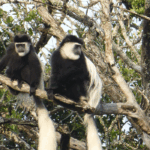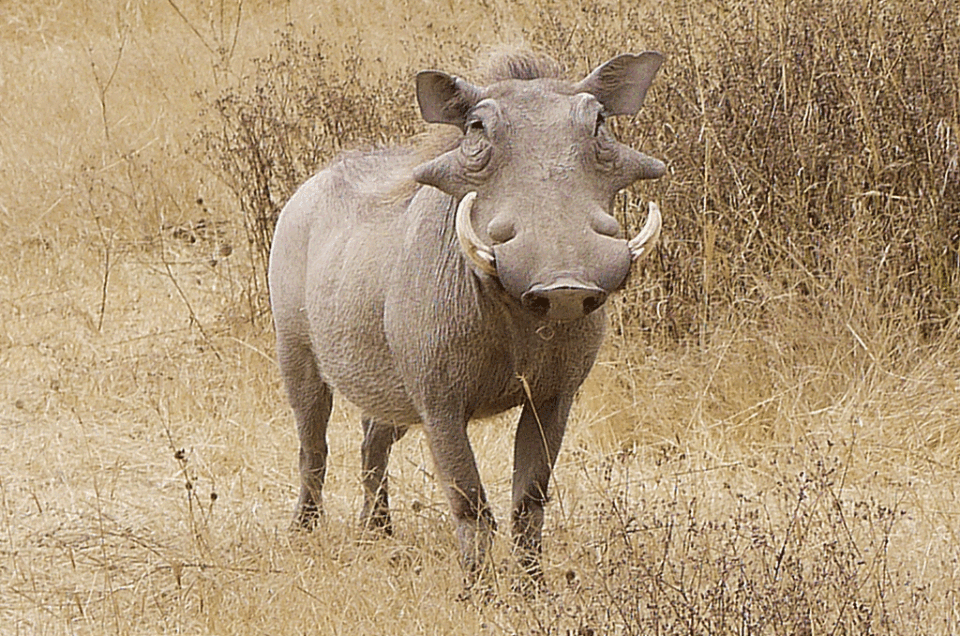T he Warthogs (Pumba) in savannah, get their name from three wart-like bumps on their head which are actually fatty lumps that protect them during fights. Warthogs are common in all of Uganda’s savannah national parks. Mirama hills safaris we plan for you a trip such you can’t miss these animals on your safari to Uganda its 100% seen.
In Uganda, the warthog is a common wild pig species found across the savannah national parks like Lake Mburo, Murchison Falls, Queen Elizabeth, and Kidepo Valley, easily recognizable by its large head with distinctive “wart-like” bumps, bristly mane, and protruding tusks; they are often seen grazing on grasses and using their snouts to dig for roots, and are known for their ability to quickly flee to safety in burrows when threatened; due to their appearance in Disney’s “The Lion King” as Pumba, warthogs are considered one of Uganda’s most famous animals.
Their most distinctive features are the large bumps on their faces that look like warts hence their name. These fleshy growths help protect warthogs, shielding their eyes and faces when they’re fighting, which occurs between males during mating season.
The warthog is a tough, sturdy animal. Males weigh 9 to 23 kilograms (20 to 50 pounds) more than females, but both are distinguished by disproportionately large heads and “warts” — thick protective pads that appear on both sides of the head.
These rooting animals are beneficial to the land by churning up the soil and allowing it to be aerated, which aids plant growth. Warthogs are generally diurnal but may be active at night in West Africa, Kenya, and Zimbabwe.
Warthogs can run as fast as 30 miles almost 48 kilometers in an hour, often outdistancing a pursuer. When cornered by predators, warthogs will attack with their sharp lower tusks, which can measure 6 inches (15 centimeters) long. Older warthogs have long curved upper tusks that can grow as long as 1ft (30.5 centimeters).
As the young ones grow up, their older ones groom them and part of this involves rubbing against termite molds and trees then letting the birds pick off these insects off their backs and taking sand baths
In case there is availability of water, the warthogs are observed to drink frequently and wallowing in the mud, a thing they really love. They love also waterholes where they dig in the mud and enjoyable wallow.
There is a common warthog fighting ritual, which they engage in that involves then clashing their heads when they charge. The fights among the males are normally very aggressive and end up into blood being spattered.
They live in family group comparing of the females and their young ones. Occasionally female may join the group. The male on the other hands stay alone and only join the group for mate and the two sexes can mate with over one partner.
Ideally, warthogs enjoy resting and sleeping in holes, which they normally line with grass, presumably to keep warm. Despite the fact that they are good excavators, they don’t dig their resting holes but instead use those dug by other wild animals like the aardvarks.
These are the only species of pigs that can live in dry areas and survive without water for the number of months. Their bodies can tolerate a temperature that is above their usual body temperature. They manage to stay hydrated by getting moisture from the tubers and other plants they eat. And caring for their young each time a female is going to give birth to a new litter, it chases off the litter that it was looking after and isolate itself. The juveniles may for sometimes stay alone and later join another loner female.
The warthog gestation period lasts between 152 and 185 days, so once we did not see any further breeding behavior between them, we suspected Eleanor was pregnant.
The females have four teats, which limits the size of the litter to just four. Each of the piglets then gets its own teat that suckles from exclusively. Actually even aid a piglet dies; the rest won’t suckle its teat. Normally they suckle for approximately four months but by two months, they begin grazing and that way they get more nourishment.
The warthogs top most enemies are the lions and leopards. These cats hunt them food but sometime they protect themselves by fleeing since they are good runners or by sliding back into their holes with their hind part of the body in first and their heads towards the top such that they can use their frightening tusks to attack any enemies.
Some researchers in the eastern Serous Game Reserve, Tanzania and other parts in east African national parks found the average lifespan of a warthog was 7 to 11 years. Other literature indicates that warthogs may live as long as 18 years in human care.








